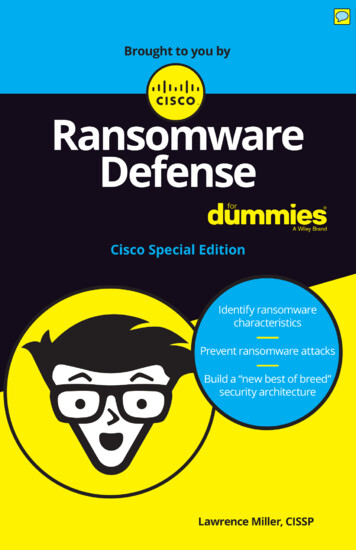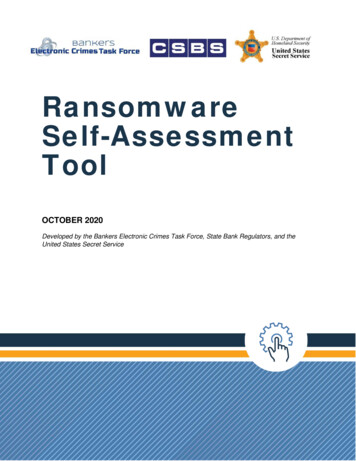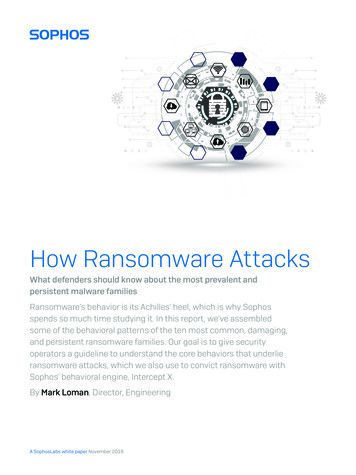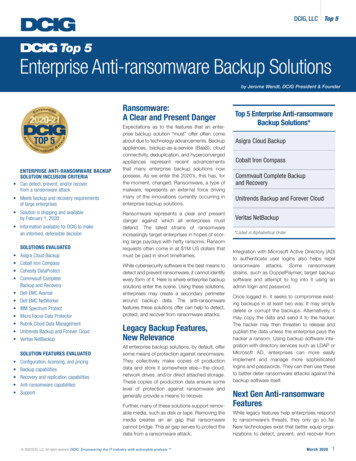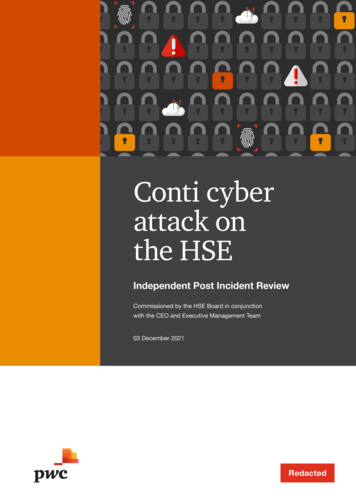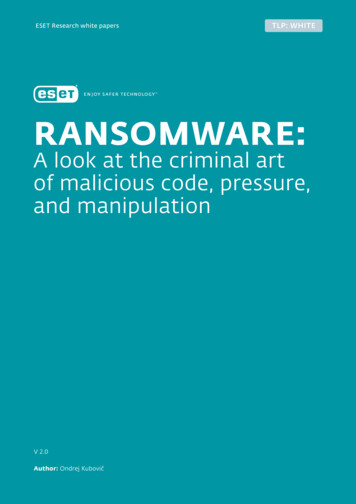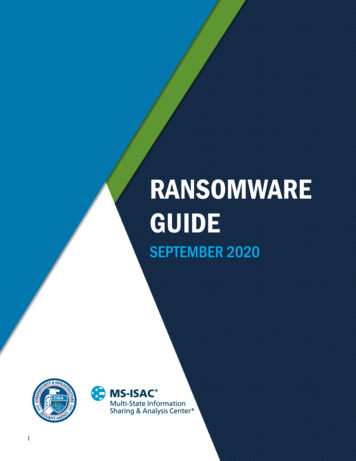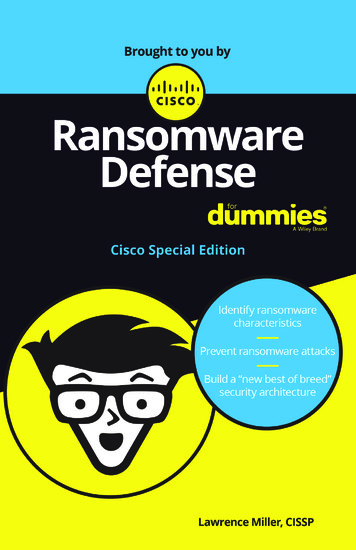
Transcription
These materials are 2017 John Wiley & Sons, Inc. Any dissemination, distribution, or unauthorized use is strictly prohibited.
RansomwareDefenseCisco Special Editionby Lawrence Miller, CISSPThese materials are 2017 John Wiley & Sons, Inc. Any dissemination, distribution, or unauthorized use is strictly prohibited.
Ransomware Defense For Dummies , Cisco Special EditionPublished byJohn Wiley & Sons, Inc.111 River St.Hoboken, NJ 07030-5774www.wiley.comCopyright 2017 by John Wiley & Sons, Inc., Hoboken, New JerseyNo part of this publication may be reproduced, stored in a retrieval system or transmitted in any form orby any means, electronic, mechanical, photocopying, recording, scanning or otherwise, except aspermitted under Sections 107 or 108 of the 1976 United States Copyright Act, without the prior writtenpermission of the Publisher. Requests to the Publisher for permission should be addressed to thePermissions Department, John Wiley & Sons, Inc., 111 River Street, Hoboken, NJ 07030, (201) 748-6011,fax (201) 748-6008, or online at http://www.wiley.com/go/permissions.Trademarks: Wiley, For Dummies, the Dummies Man logo, The Dummies Way, Dummies.com, MakingEverything Easier, and related trade dress are trademarks or registered trademarks of John Wiley & Sons,Inc. and/or its affiliates in the United States and other countries, and may not be used without writtenpermission. All other trademarks are the property of their respective owners. John Wiley & Sons, Inc., isnot associated with any product or vendor mentioned in this book.LIMIT OF LIABILITY/DISCLAIMER OF WARRANTY: THE PUBLISHER AND THE AUTHOR MAKE NOREPRESENTATIONS OR WARRANTIES WITH RESPECT TO THE ACCURACY OR COMPLETENESS OF THECONTENTS OF THIS WORK AND SPECIFICALLY DISCLAIM ALL WARRANTIES, INCLUDING WITHOUTLIMITATION WARRANTIES OF FITNESS FOR A PARTICULAR PURPOSE. NO WARRANTY MAY BE CREATEDOR EXTENDED BY SALES OR PROMOTIONAL MATERIALS. THE ADVICE AND STRATEGIES CONTAINEDHEREIN MAY NOT BE SUITABLE FOR EVERY SITUATION. THIS WORK IS SOLD WITH THE UNDERSTANDINGTHAT THE PUBLISHER IS NOT ENGAGED IN RENDERING LEGAL, ACCOUNTING, OR OTHER PROFESSIONALSERVICES. IF PROFESSIONAL ASSISTANCE IS REQUIRED, THE SERVICES OF A COMPETENT PROFESSIONALPERSON SHOULD BE SOUGHT. NEITHER THE PUBLISHER NOR THE AUTHOR SHALL BE LIABLE FORDAMAGES ARISING HEREFROM. THE FACT THAT AN ORGANIZATION OR WEBSITE IS REFERRED TOIN THIS WORK AS A CITATION AND/OR A POTENTIAL SOURCE OF FURTHER INFORMATION DOES NOTMEAN THAT THE AUTHOR OR THE PUBLISHER ENDORSES THE INFORMATION THE ORGANIZATION ORWEBSITE MAY PROVIDE OR RECOMMENDATIONS IT MAY MAKE. FURTHER, READERS SHOULD BE AWARETHAT INTERNET WEBSITES LISTED IN THIS WORK MAY HAVE CHANGED OR DISAPPEARED BETWEENWHEN THIS WORK WAS WRITTEN AND WHEN IT IS READ.ISBN 978-1-119-35226-6 (pbk); ISBN 978-1-119-35215-0 (ebk)Manufactured in the United States of America10 9 8 7 6 5 4 3 2 1For general information on our other products and services, or how to create a custom For Dummies bookfor your business or organization, please contact our Business Development Department in the U.S. at877-409-4177, contact info@dummies.biz, or visit www.wiley.com/go/custompub. For informationabout licensing the For Dummies brand for products or services, contact BrandedRights&Licenses@Wiley.com.Publisher’s AcknowledgmentsSome of the people who helped bring this book to market include the following:Development Editor: Elizabeth KuballProduction Editor: Siddique ShaikCopy Editor: Elizabeth KuballSpecial Help: Rachel Ackerly, MaryBriggs, Dan Gould, Aivy Iniguez,Kate MacLean, Ben Munroe,Mark MurtaghAcquisitions Editor: Amy FandreiEditorial Manager: Rev MengleBusiness Development Representative:Karen HattanThese materials are 2017 John Wiley & Sons, Inc. Any dissemination, distribution, or unauthorized use is strictly prohibited.
Table of ContentsINTRODUCTION. 1About This Book. 1Foolish Assumptions. 1Icons Used in This Book. 2Beyond the Book. 2CHAPTER 1:What Is Ransomware?. 3Defining Ransomware. 3Recognizing Ransomware in the Modern Threat Landscape. 4Understanding How Ransomware Operates. 7CHAPTER 2:Implementing Best Practices to ReduceRansomware Risks. 9Before an Attack: Discover, Enforce, Harden. 9During an Attack: Detect, Block, and Defend. 14After an Attack: Scope, Contain, and Remediate. 15CHAPTER 3:Building the “New Best-of-Breed”Security Architecture. 17Recognizing the Limitations of Current Security Designs. 17Defining the “New Best-of-Breed” Security Architecture. 19CHAPTER 4:Deploying Cisco Ransomware Defense. 25Leveraging DNS as the First Line of Defense in the Cloud. 25Securing Endpoints and Addressing Email Threats. 30Cisco Advanced Malware Protection (AMP)for Endpoints. 31Cisco Email Security with Advanced MalwareProtection (AMP). 32Protecting the Network with Next-Generation Firewalls andSegmentation. 34Cisco Firepower Next-Generation Firewall (NGFW). 34Use the network as a sensor and enforcer. 35Streamlining Deployments and BolsteringIncident Response. 36Table of ContentsiiiThese materials are 2017 John Wiley & Sons, Inc. Any dissemination, distribution, or unauthorized use is strictly prohibited.
CHAPTER 5:Ten Key Ransomware Defense Takeaways. 39Ransomware Is Evolving. 39Ransomware-as-a-Service Is an Emerging Threat. 40Paying a Ransom Doesn’t Solve Your Security Problems. 40Build a Layered Security Architecture Based onOpen Standards. 41Deploy Integrated, Best-of-Breed Solutions. 42Embed Security throughout Your Network Environment. 42Reduce Complexity in Your Security Environment. 42Leverage Cloud-Based, Real-Time Threat Intelligence. 43Automate Security Actions to Reduce Response Time. 43See Something, Say Something. 43ivRansomware Defense For Dummies, Cisco Special EditionThese materials are 2017 John Wiley & Sons, Inc. Any dissemination, distribution, or unauthorized use is strictly prohibited.
IntroductionThe rise of ransomware over the past few years is an evergrowing problem that has quickly become an extremelylucrative criminal enterprise. Targeted organizations oftenbelieve that paying the ransom is the most cost-effective way toget their data back — and, unfortunately, this may be true. Theproblem is that every single business that pays to recover its filesis directly funding the development of the next generation ofransomware. As a result, ransomware is evolving at an alarmingrate with new and more sophisticated variants.Ransomware must be prevented when possible, detected whenit attempts to breach a network, and contained to limit potential damage when it infects systems and endpoints. Ransomwaredefense calls for a “new best-of-breed” architectural approachthat spans the organization at the edge in the domain name system (DNS) layer to the data center and across endpoint devices nomatter where they’re being used.About This BookRansomware Defense For Dummies consists of five short chaptersthat explore how ransomware operates and its defining characteristics (Chapter 1), security best practices to reduce ransomwarerisks (Chapter 2), a “new best-of-breed” security architecture(Chapter 3), the Cisco Ransomware Defense solution (Chapter 4),and important ransomware defense takeaways (Chapter 5).Foolish AssumptionsIt has been said that most assumptions have outlived their uselessness, but I assume a few things nonetheless!Mainly, I assume that you know a few things about information security. Perhaps you’re a C-level IT executive, IT director,senior IT architect, analyst, or manager, or a security, network,or system administrator. As such, this book is written primarilyIntroduction1These materials are 2017 John Wiley & Sons, Inc. Any dissemination, distribution, or unauthorized use is strictly prohibited.
for technical readers who know a little something about IT networking, infrastructure, and enterprise systems.If any of these assumptions describes you, then this book is foryou! If none of these assumptions describes you, keep readinganyway. It’s a great book, and when you finish reading it, you’llknow enough about ransomware defense to be dangerous (to thebad guys)!Icons Used in This BookThroughout this book, I use special icons to call attention toimportant information. Here’s what to expect:This icon points out information that you should commit to yournonvolatile memory, your gray matter, or your noggin — alongwith anniversaries and birthdays!You won’t find a map of the human genome here, but if you seekto attain the seventh level of NERD-vana, perk up! This iconexplains the jargon beneath the jargon and is the stuff legends —well, nerds — are made of!Thank you for reading, hope you enjoy the book, please take careof your writers! Seriously, this icon points out helpful suggestionsand useful nuggets of information.This icon points out the stuff your mother warned you about.Okay, probably not. But you should take heed nonetheless — youmight just save yourself some time and frustration!Beyond the BookThere’s only so much I can cover in 48 short pages, so ifyou find yourself at the end of this book, thinking, “Gosh,this was an amazing book. Where can I learn more?,” just go towww.cisco.com/go/ransomware.2Ransomware Defense For Dummies, Cisco Special EditionThese materials are 2017 John Wiley & Sons, Inc. Any dissemination, distribution, or unauthorized use is strictly prohibited.
IN THIS CHAPTER»» Identifying ransomware and its definingcharacteristics»» Looking at ransomware trends»» Seeing how ransomware worksChapter1What Is Ransomware?Ransomware is the fastest-growing malware threat todayand is already an epidemic. According to a U.S. governmentinteragency report, an average of more than 4,000 ransomware attacks have occurred daily since January 2016. In this chapter, you learn about ransomware — what it is, how it’s evolvingas a threat, and how it works.Defining RansomwareRansomware is malicious software (malware) used in a cyberattack to encrypt the victim’s data with an encryption key that isknown only to the attacker, thereby rendering the data unusableuntil a ransom payment (usually cryptocurrency, such as Bitcoin) ismade by the victim.Cryptocurrency is an alternative digital currency that uses encryption to regulate the “printing” of units of currency (such asbitcoins) and to verify the transfer of funds between parties,without an intermediary or central bank.Ransom amounts are typically high, but not exorbitant. For example, demands for individuals typically range from 300 to 600,while larger organizations will typically pay more. In 2016, a SouthCarolina school district paid an estimated 10,000 ransom and aCalifornia hospital paid approximately 17,000 to cybercriminals.These amounts quickly add up — more than 200 million in theCHAPTER 1 What Is Ransomware?3These materials are 2017 John Wiley & Sons, Inc. Any dissemination, distribution, or unauthorized use is strictly prohibited.
first three months of 2016, according to the U.S. Federal Bureauof Investigation (FBI). This characteristic of ransomware is bydesign, in an effort to get victims to simply pay the ransom asquickly as possible, instead of contacting law enforcement andpotentially incurring far greater direct and indirect costs due tothe loss of their data and negative publicity.Ransom amounts may also increase significantly the longer a victim waits. Again, this is by design, in an effort to limit a victim’soptions and get the victim to pay the ransom as quickly as possible.Recognizing Ransomware in theModern Threat LandscapeRansomware is not a new threat (see Figure 1-1). The earliestknown ransomware, known as PC Cyborg, was unleashed in 1989.Since that time, ransomware has evolved and become far moresophisticated. Ransomware has also become more pervasive andlucrative with developments such as the following:»» The release of the Android phone: Android has become apopular attack vector (macOS is also now a target, and AppleiOS will no doubt become a target).»» The rise of Bitcoin: Bitcoin enables easy and virtuallyuntraceable payments to anonymous cybercriminals.»» The emergence of Ransomware-as-a-Service (RaaS): RaaS(ransomware that can be purchased for a small fee and/or apercentage of the ransom payment) makes it easy forpractically anyone to use ransomware.Despite sensational media reports about massive data breachestargeting organizations and enterprises such as the U.S. Office ofPersonnel Management (OPM), Anthem Blue Cross Blue Shield,Target, and Home Depot, for identity theft and credit card fraudpurposes, the rise of ransomware has become one of the mostpervasive threats to organizations and enterprises — as well asindividuals — over the past year.A report by the Institute for Critical Infrastructure Technology (ICIT) predicts that 2016 will be the year that ransomware“wreak[s] havoc on America’s critical infrastructure community.”4Ransomware Defense For Dummies, Cisco Special EditionThese materials are 2017 John Wiley & Sons, Inc. Any dissemination, distribution, or unauthorized use is strictly prohibited.
FIGURE 1-1: The evolution of ransomware.CHAPTER 1 What Is Ransomware?5These materials are 2017 John Wiley & Sons, Inc. Any dissemination, distribution, or unauthorized use is strictly prohibited.
Locky is one example of an aggressive ransomware variant thatis believed to be compromising as many as 90,000 victims perday. The average ransom for Locky is usually between 0.5 and1 Bitcoin. Based on statistics from Cisco’s Talos threat intelligence group, on average, 2.9 percent of compromised victims in a ransomware attack will pay the ransom. Thus, Locky could potentially infect as many as 33 million victims over a 12-month period,resulting in between 287 million and 574 million in ransompayments (see Table 1-1).TABLE 1-1Estimate of Locky Total Ransom PaymentsRansom Price1 Bitcoin0.5 BitcoinVictims/day90,00090,000Number of payouts/day2,6102,610Current Bitcoin price (as ofOctober 2, 2016) 610.82 1 Bitcoin 610.82 1 Bitcoin1-day profits 1,594,240 797,1201-month profits 47,826,206 23,913,60312-month profits 573,926,472 286,963,236Although a conservative estimate of 287 million may seem trivialin comparison to even a single data breach (such as the Target databreach, which is estimated to have cost Target over 300 million),it’s important to remember that data breach loss estimates arebased on costs to the organization that is targeted, not the individual victims whose identities and/or credit card information isstolen. Costs to the organization include the following:»» Regulatory fines and penalties levied by various regulatorybodies, such as the Payment Card Industry (PCI)»» Legal fees associated with litigation resulting from thebreach»» Loss of business due to business interruptions, brandreputation damage, and loss of customers»» Remediation including incident response and recovery,public relations, breach notifications, and credit monitoringservices for affected individuals6Ransomware Defense For Dummies, Cisco Special EditionThese materials are 2017 John Wiley & Sons, Inc. Any dissemination, distribution, or unauthorized use is strictly prohibited.
The Ponemon Institute reports that the average cost of a databreach for targeted organizations is approximately 6.5 million.Cybercriminals typically sell stolen credit card and identityinformation on the dark web — anonymous web content (suchas black market drug sales, child pornography, cybercrime, orother activities attempting to avoid surveillance or censorship)that requires special software, configuration, and/or authorization for access — for as little as a few cents to several dollars perrecord. The 2015 Cost of Cyber Crime Study by the Ponemon Institute reported that the average selling price for stolen U.S. creditcard data is approximately 0.25 to 60 per card. By comparison,a cybercriminal can make several hundred dollars to tens of thousands of dollars from ransoms directly paid to them by individualvictims and organizations.The actual cost to victims of identity theft and credit card fraudwas estimated in Javelin Strategy and Research’s 2016 IdentityFraud Study to be 15 billion in 2015. The study also reveals that,although the number of U.S. victims of identity theft and creditcard fraud has remained relatively steady since 2012, averagingapproximately 12.8 million individual victims, fraud losses havedeclined by approximately 25 percent — meaning profits forcybercriminals, while still significant, are also declining.In contrast to the declining trend in identity theft and credit cardfraud, the FBI reported a tenfold increase in ransomware crimesover the previous year during just the first three months of 2016.The cost to U.S. victim organizations and businesses is conservatively estimated to be more than 200 million, putting ransomware on pace to be a 1 billion crime in 2016.Understanding How RansomwareOperatesRansomware is commonly delivered through exploit kits, waterhole attacks (in which one or more websites that an organizationfrequently visits is infected with malware), malvertising (malicious advertising), or email phishing campaigns (see Figure 1-2).CHAPTER 1 What Is Ransomware?7These materials are 2017 John Wiley & Sons, Inc. Any dissemination, distribution, or unauthorized use is strictly prohibited.
FIGURE 1-2: How ransomware infects an endpoint.Go to https://youtu.be/4gR562GW7TI to see the anatomy of aransomware attack.Once delivered, ransomware typically identifies user files and datato be encrypted through some sort of an embedded file extensionlist. It’s also programmed to avoid interacting with certain systemdirectories (such as the WINDOWS system directory, or certain program files directories) to ensure system stability for delivery of theransom after the payload finishes running. Files in specific locationsthat match one of the listed file extensions are then encrypted. Otherwise, the file(s) are left alone. After the files have been encrypted,the ransomware typically leaves a notification for the user, withinstructions on how to pay the ransom (see Figure 1-3).FIGURE 1-3: How ransomware works.There is no honor among thieves. Although an attacker willusually provide the decryption key for your files if you pay theransom, there is no guarantee that the attacker hasn’t alreadyinstalled other malware and exploit kits on your endpoint or othernetworked systems, or that they won’t steal your data for othercriminal purposes or to extort more payments in the future.8Ransomware Defense For Dummies, Cisco Special EditionThese materials are 2017 John Wiley & Sons, Inc. Any dissemination, distribution, or unauthorized use is strictly prohibited.
IN THIS CHAPTER»» Being proactive about ransomwaredefense»» Automating ransomware defenses forrapid response»» Regrouping after an attack has occurredChapter2Implementing BestPractices to ReduceRansomware RisksIn this chapter, I review security best practices and risk mitigation strategies that, if fully and correctly applied, will help yourorganization effectively defend against ransomware and othercybersecurity threats.Before an Attack: Discover,Enforce, HardenThere are, of course, a number of best practices that organizationscan proactively implement before they’re ever targeted by anattacker. If attackers can’t easily establish an initial foothold —get their foot in the door, so to speak — they’ll likely seek aneasier victim, unless your organization is the object of a targetedattack.Ransomware attacks can be opportunistic — the attacker’smotive is often profit, with as little risk and effort as possible.CHAPTER 2 Implementing Best Practices to Reduce Ransomware Risks9These materials are 2017 John Wiley & Sons, Inc. Any dissemination, distribution, or unauthorized use is strictly prohibited.
So, preventing an attacker from gaining entry to your networkwith an architectural approach is the most effective way to breakthe “cyber kill chain” and prevent a ransomware attack from succeeding in the first place.The Lockheed Martin Cyber Kill Chain model consists of sevenattack phases: Reconnaissance, Weaponization, Delivery, Exploitation, Installation, Command and Control (C2), and Actions onthe Objective. The first five phases are all focused on gainingaccess to the target’s network and systems.Attackers usually achieve initial access to a target through one oftwo methods:»» Social engineering/phishing to get an unsuspecting user toexpose her network credentials or install malware»» Exploiting a vulnerability in a public-facing (Internet) application or serviceWith regard to phishing attacks and security awareness training, Verizon’s 2016 Data Breach and Investigations Report (DBIR)bemoans, “Apparently, the communication between the criminaland the victim is much more effective than the communicationbetween employees and security staff.”The following best practices should be implemented to preventattackers from gaining access to your organization’s network andsystems:»» Conduct regular security awareness and training foryour end users. This training should be engaging andcontain the latest information on security threats and tactics.Be sure to do the following:10 Reinforce company policies regarding not sharing orrevealing user credentials (even with IT and/or security),strong password requirements, and the role of authentication in security (including the concept of nonrepudiation,which gives users the “It wasn’t me!” defense). Encourage the use of company-sanctioned Software-as-aService (SaaS) applications, such as file-sharing programs,to exchange documents with others rather than emailRansomware Defense For Dummies, Cisco Special EditionThese materials are 2017 John Wiley & Sons, Inc. Any dissemination, distribution, or unauthorized use is strictly prohibited.
attachments, as a way to mitigate (or completely eliminate) phishing attacks containing malicious attachments. Consider non-native document rendering for PDF andMicrosoft Office files in the cloud. Desktop applicationssuch as Adobe Acrobat Reader and Microsoft Word oftencontain unpatched vulnerabilities that can be exploited. Instruct users who do not regularly use macros to neverenable macros in Microsoft Office documents. A resurgence in macro-based malware has been observedrecently that uses sophisticated obfuscation techniquesto evade detection. Explain incident reporting procedures and ensure thatusers feel comfortable reporting security incidents withmessages like “You’re the victim, not the perp” and “Thecover-up is worse (in terms of damage) than the event.” Remember to cover physical security. Although they’reless common than other forms of social engineering,visitor escort policies and tactics such as dumpster diving,shoulder surfing, and piggybacking (or tailgating), whichpotentially threaten their personal safety as well asinformation security, should be reiterated to users.»» Perform ongoing risk assessments to identify anysecurity weaknesses and vulnerabilities in your organization, and address any threat exposures to reduce risk.Be sure to do the following: Conduct periodic port and vulnerability scans. Enforce strong password requirements and implementtwo-factor authentication (where possible). Centralize security logging on a secure log collector orsecurity incident and event management (SIEM) platform,and frequently review and analyze log information.Ensure solid and timely patch management.Disable unnecessary and vulnerable services and followsystem hardening guidance.Unfortunately, despite your best efforts, people are people(and Soylent Green is people!) and there will always be zeroday threats that exploit previously unknown — and therefore,CHAPTER 2 Implementing Best Practices to Reduce Ransomware Risks11These materials are 2017 John Wiley & Sons, Inc. Any dissemination, distribution, or unauthorized use is strictly prohibited.
unpatched — vulnerabilities. If an attacker succeeds in accessingyour network, his next step is to establish C2 communications, inorder to»» Ensure persistence»» Escalate privileges»» Move laterally throughout your network, data center, andend user environmentTo mitigate the effects of a successful intrusion, implement thefollowing best practices:»» Deploy domain name system (DNS) layer protection thatenables you to predictively identify malicious domains, IPaddresses, and Internet infrastructure to help mitigate therisk of an attack.»» Automatically enable firewall, advanced malware protection,encryption, and data loss prevention on all endpoints,including personal mobile devices (if “bring your own device”[BYOD] is permitted) and removable media (such as USBdrives) that is transparent to the user and requires no actionby the user. This protects roaming and remote users both onand off the network, even when they don’t necessarily dowhat they’re supposed to do with regard to best practicesand established policies.»» Enable security functionality on email gateways includingblocking or removing executables and other potentiallymalicious attachments, sender policy framework (SPF)verification to mitigate email spoofing, and email throttling(or “graylisting”) to rate-limit potential spam emails.»» Enable security products and services that analyze Internettraffic, emails, and files to prevent infection and dataexfiltration (discussed further in Chapters 3 and 4), andleverage threat intelligence services for deeper context andrapid investigation.»» Design and deploy a robust, inherently secure securityarchitecture that uses segmentation to restrict an attacker’slateral movement in your environment.12Ransomware Defense For Dummies, Cisco Special EditionThese materials are 2017 John Wiley & Sons, Inc. Any dissemination, distribution, or unauthorized use is strictly prohibited.
»» Enforce the principle of least privilege and eliminate user“privilege creep” to limit an attacker’s ability to escalateprivileges.»» Regularly back up critical systems and data, and periodicallytest backups to ensure they can be restored and are good.Also encrypt your backups and maintain them offline or on aseparate backup network.»» Assess and practice your incident response capabilities, andmonitor and measure the overall effectiveness of yoursecurity posture on an ongoing and continual basis.Most ransomware relies on a robust C2 communications infrastructure, for example, to transmit encryption keys and paymentmessages. By preventing an attacker from connecting with ransomware that has infected its network, an organization can stopa successful ransomware attack. If, for example, the attacker isunable to send encryption keys to an infected endpoint or instructa victim on how to send a ransom payment, the ransomwareattack will fail. As Table 2-1 shows, the most common ransomware variants today rely heavily on DNS for C2 communications.In some cases, a Tor (The Onion Router) browser is also used forC2 communications.TABLE 2-1NameC2 communications in ransomware.Encryption KeyPayment TorrentLockerDNSDNSPadCryptDNSDNS, TorCTB-LockerDNS, TorDNSFAKBENDNSDNS, TorPayCryptDNSDNSKeyRangerDNS, TorDNS**Top variants as of March 2016CHAPTER 2 Implementing Best Practices to Reduce Ransomware Risks13These materials are 2017 John Wiley & Sons, Inc. Any dissemination, distribution, or unauthorized use is strictly prohibited.
During an Attack: Detect,Block, and DefendIf your organization is under attack, fast and effective incidentresponse is required to limit any potential damage. The specificaction steps and remediation efforts to be undertaken will bedifferent for each unique situation. However, the time to learnthe breadth and extent of your organization’s incident responsecapabilities is not during an attack! Your incident response effortsshould be well understood and coordinated — which is accomplished before an attack — and well documented and repeatable,so that you can reconstruct an incident after an attack and identify lessons learned and potential areas for improvement.A key component of effective incident response that is often overlooked is information sharing, which includes the following:»» Communicating timely and accurate information to allstakeholders: Pertinent information needs to be providedto executives in ord
Oct 02, 2016 · Ransomware Defense For Dummies . Protecting the Network with Next-Generation Firewalls and Segmentation. 34 Cisco Firepower Next-Generation Firewall (NGFW) . 34 Use the network as a
